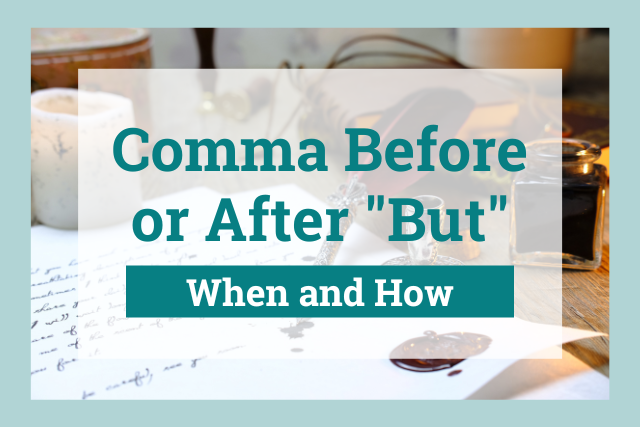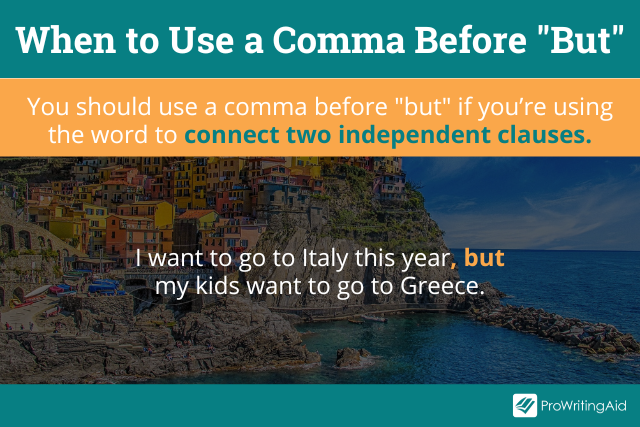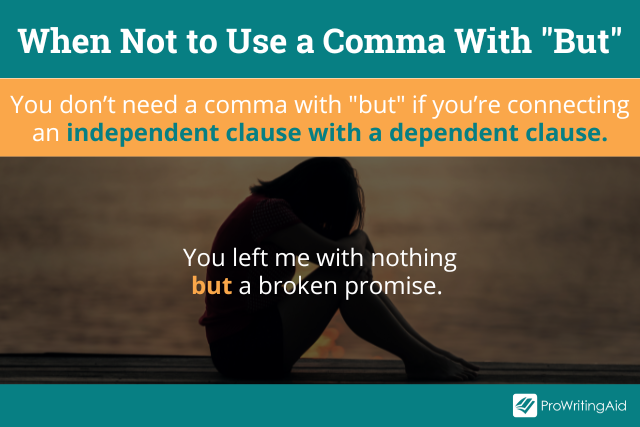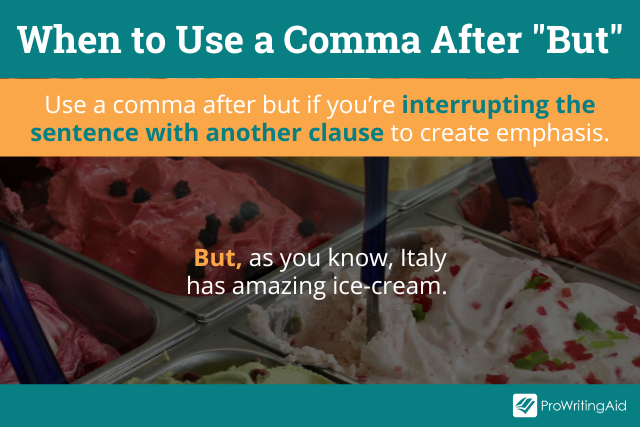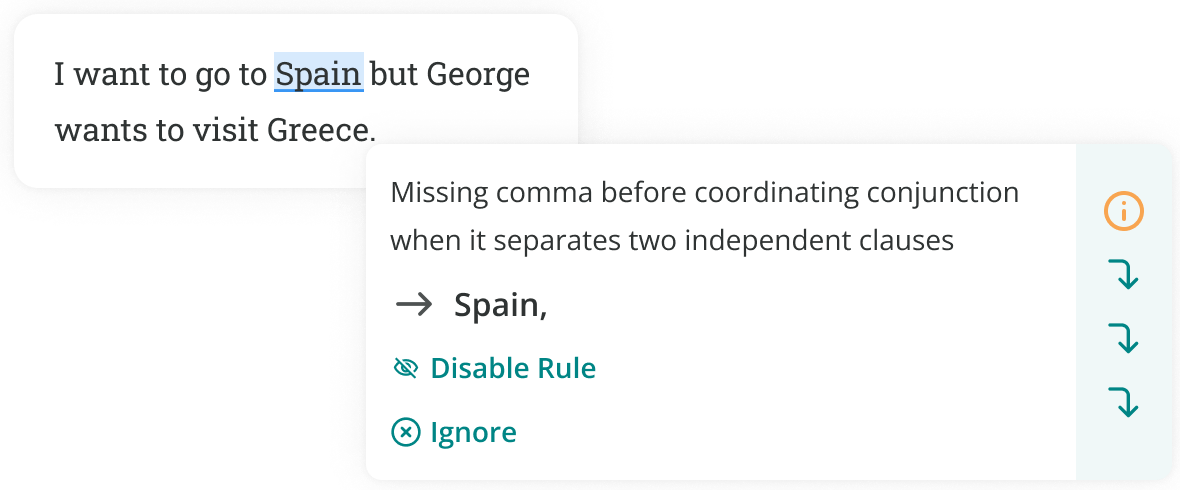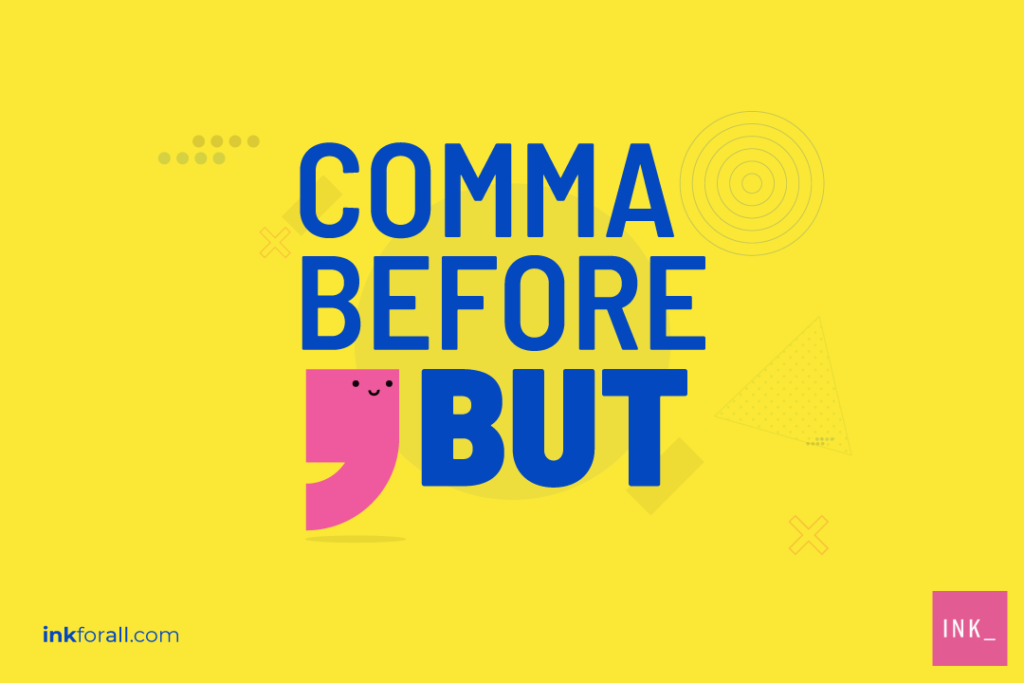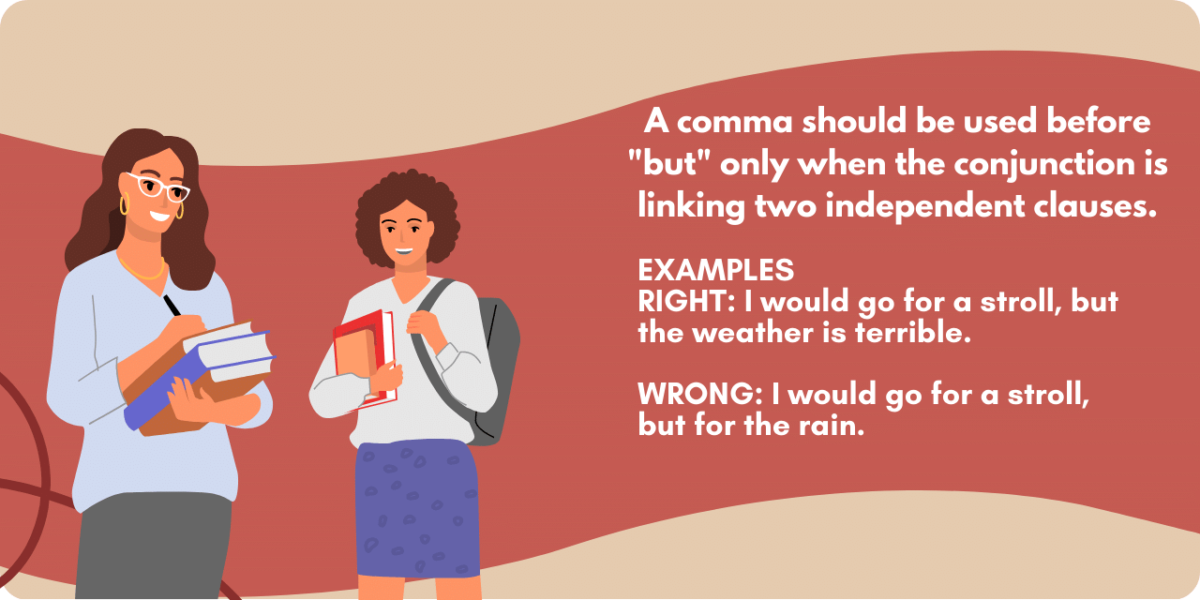If the clause after «but» has a subject and a verb, you need a comma before but. If the clause introduced by «but» does not have a subject in front of the second verb, the comma is often optional.
If the clause after «but» has a subject and a verb, you need a comma before but.
My sister loves cake, but she wants to avoid gaining weight.
My sister loves cake but she wants to avoid gaining weight.
If the clause introduced by «but» does not have a subject in front of the second verb, the comma is often optional. But you can use it to show more contrast or indicate a pause.
I love shopping but don’t have any money.
I love shopping, but don’t have any money.
Contents
- 1. Use a Comma to Introduce an Independent Clause
- 2. The Comma is Optional When Introducing a Dependent Clause
- 3. Other Rules for Placing a Comma Before ‘But’
- 3.1 Use a comma if the clause does not limit or define
- 3.2 Add commas to set off expressions that interrupts the sentence flow
- 3.3 Insert a comma before ‘but’ to separate contrasting parts of a sentence
- 4. More Examples
- 5. Conclusion
- 6. References
1. Use a Comma to Introduce an Independent Clause
As a coordinating conjunction, but joins two clauses of a sentence. If the second clause can stand alone (it has a subject and a verb and forms a complete sentence), add a comma before but.
My brother loves watching TV, but he doesn’t like reading.
My brother loves watching TV but he doesn’t like reading.
Notice that both clauses on either side of the comma can stand alone.
Follow the same rules when using a comma before «and», «or», and other coordinating conjunctions such as «so», «for», «nor», or «yet».
My brother is an artist, and he loves painting.
My brother is an artist and he loves painting.
2. The Comma is Optional When Introducing a Dependent Clause
In some sentences, you don’t need to repeat the subject after but because it is the same in both clauses.
I understand Spanish but cannot speak it.
In the example above, «cannot speak it» is not an independent clause—it cannot stand alone. An independent clause needs a subject and a verb. In this situation, the comma before «but» is optional.
I understand Spanish, but cannot speak it.
Some writers minimize punctuation usage, while others prefer to use more commas to give readers a chance to pause and take a breath.
The classic Blue Book of Grammar and Punctuation argues that using a comma is generally unnecessary when the subject does not appear in front of the second verb.
❝ If the subject does not appear in front of the second verb, a comma is generally unnecessary. Example: Morty thought quickly but still did not answer correctly.❞
Kaufman, Lester; Straus, Jane. The Blue Book of Grammar and Punctuation.
Other authors, however, recommend using a comma if the conjunction is but:
❝ When the subject is the same for both clauses and is expressed only once, a comma is useful if the connective is but. When the connective is and, the comma should be omitted if the relation between the two statements is close or immediate. ❞
Strunk JR., William; White, E.B. The Elements of Style.
As a general rule, you can choose whether to include a comma before but after considering a range of factors, including clarity, emphasis, and rhythm. In any case, add a comma if it makes the sentence clearer.
3. Other Rules for Placing a Comma Before ‘But’
3.1 Use a comma if the clause does not limit or define
Insert a comma before «but» if the second clause does not limit or define; it merely adds something.(1)
For example:
It is not very common, but certainly possible.
By saying «it is not very common», you are already implying that it is possible. Therefore, the phrase «certainly possible» does not limit or define. It just adds information to the main part of the sentence.
3.2 Add commas to set off expressions that interrupts the sentence flow
Use commas to set off expressions that interrupts the flow of a sentence.(1)
I want to go, but not this year, to Italy.
I want to go but not this year to Italy.
3.3 Insert a comma before ‘but’ to separate contrasting parts of a sentence(1)
For example:
The money is in your wallet, but it’s not yours.
4. More Examples
The second clause of these sentences are independent clauses; therefore, we place a comma before but:
- I tried to become a famous singer, but my father ruined it.
- It will be a painful process, but she has no other choice.
- I know it is expensive, but you have a lot of money.
- Yes, I know that you are tired, but you’re not finished.
- It sounds really interesting, but I have decided that I must decline your offer.
- John learns fast, but his attention span is very short.
These are some examples where the comma before but is optional:
- Yes, I have a lot of money, but not for your crazy ideas.
- They are working slowly but surely.
- I bought the car but can’t drive.
- Yes, I know that I am distracted, but cannot take my eyes off that girl when she’s talking.
- The food was good but not delicious.
- I would buy the red one but is too expensive.
5. Conclusion
Follow these guidelines to decide whether to use a comma before but:
- Include a comma before «but» to introduce an independent clause.
- If the subject does not appear in front of the second verb, the comma before «but» is optional.
6. References
(1) Kaufman, Lester; Straus, Jane. The Blue Book of Grammar and Punctuation. Chapter 2 (punctuation).
(2) Strunk JR., William; White, E.B. The Elements of Style.
Should you use a comma before but or after but?
You should use a comma before but whenever you’re connecting two independent clauses. It’s much rarer to use a comma after but.
In this article, we explain this comma rule and give you examples of sentences that use commas before and after but.
Do You Put the Comma Before or After But?
There are three possible situations you might encounter when it comes to using a comma with the word but.
You might need to use a comma before but, you might need to use a comma after but, and you might not need to use a comma at all.
Let’s look at each of these punctuation rules in more detail.
Comma Before But
You should use a comma before but if you’re using the word but to connect two independent clauses.
An independent clause is a string of words that can stand on its own as a complete sentence, with a subject and an object.
For example, “I love food” and “I hate cooking” are both independent clauses.
If you join those two independent clauses with a conjunction, such as “and,” “or,” or “but,” you should use a comma where the period would have been after the first independent clause.
For example, you would use a comma in this sentence: “I love food, but I hate cooking.”
Here are a few more examples of cases when you need to include a comma before but:
- I have a gym membership, but I rarely use it.
- This restaurant has great service, but the food is quite expensive.
- You’re a very nice person, but I only see you as a friend.
Notice that all of the above examples use the word but to connect two independent clauses, both of which could stand alone as complete sentences.
No Comma Before or After But
You don’t need to use a comma before or after but if you’re connecting an independent clause with a dependent clause.
We defined independent clauses earlier. A dependent clause, in contrast, is a string of words that doesn’t form a complete sentence.
For example, the phrase, “only if it’s well-cooked” is a dependent clause. Thus, you wouldn’t use a comma in the following sentence: “I love food but only if it’s well-cooked.”
Here are some other examples of cases when you don’t need a comma:
- Sarah has seven cats but only one dog.
- You had a birthday party but didn’t tell me about it?
- I’m very busy but not because of work.
Notice that in each of the above examples, the clause that follows the word but is dependent, meaning it isn’t a grammatically complete sentence on its own.
Comma After But
Using a comma after but is much rarer than using a comma before but.
You should only do this when you’re interrupting the sentence flow with another word or clause immediately after the word but, to create emphasis.
For example, you might write, “But, my dear, you didn’t tell me the whole story.” In this case, the phrase “my dear” is an interrupter that adds dramatic literary effect.
Here are some other examples of cases when you might include a comma after but:
- “But, as you know, the dodo bird went extinct long ago.”
- “I enjoyed the book, but, to be honest, I didn’t completely understand it.”
- “I tried to go to the grocery store, but, as it turns out, it closed early.”
Notice that all of the above examples include an interrupter immediately after the word but.
Remember that this is a rare situation, so most of the time, you should avoid using a comma after but.
If you’re unsure whether to use a comma before or after but, you can run your writing through ProWritingAid to see if you’re placing all your commas correctly.
When to Use a Comma Before But
The best way to learn grammar rules is by studying examples. Let’s take a closer look at some examples of comma usage from English literature.
Examples of Times to Use a Comma Before But
“Family is a story that is told to you, but the story that matters most you must tell yourself.”—Ken Liu, The Hidden Girl and Other Stories
“She’d always been a great liar. The only difference between lying and acting was whether your audience was in on it, but it was all a performance just the same.”—Brit Bennett, The Vanishing Half
“The rules aren’t written down anywhere, but the important rules rarely are.”—Alix E. Harrow, The Once and Future Witches
Examples of Times to Use No Comma Before or After But
“There was nothing else to do but continue, no matter how frightened she might be.”—Shelley Parker-Chan, She Who Became the Sun
“She was going to elaborate but lost courage when she saw Martha’s expression darken.”—Clare Chambers, Small Pleasures
“They left her in Merilance with nothing but a book.”—V.E. Schwab, Gallant
Examples of Times to Use a Comma After But
“But, of course, Billy felt like it was just people attacking him. When you have everything, someone else getting a little something feels like they’re stealing from you.”—Taylor Jenkins Reid, Daisy Jones & The Six
“I school my face to blankness, but, inside, my emotions are raging like a creek after a spring storm.”—Justina Ireland, Dread Nation
“Nobody’s perfect, she liked to say. But, man, we all fall short so beautifully.”—Richard Powers, Bewilderment
Commas Can Be Complicated, But Here’s One Simple Rule
Now you know when to use a comma before and after but. Remember to use a comma before but only when you’re connecting two independent clauses, and you’ll be good to go!
Take your writing to the next level:
20 Editing Tips from Professional Writers
Whether you are writing a novel, essay, article, or email, good writing is an essential part of communicating your ideas.
This guide contains the 20 most important writing tips and techniques from a wide range of professional writers.

Comma usage can be tricky, and one question that pops up repeatedly is: When to put a comma beforebut? This guide will help you understand how to use commas before and after the conjunction but. We’ll also share a few other tricks of the trade to make using commas easier.
Main Comma Before But Takeaways:
- You need to put a comma beforebut if but connects two independent clauses.
- Independent clauses can stand alone as a sentence. They must express a complete thought.
- A dependent clause doesn’t express a complete thought, so it cannot stand alone as a sentence.
- A comma before but isn’t necessary if both independent clauses are simple and closely related.
- When the but links dependent and independent clauses, no comma is required.
- The only time a comma should follow but is when the but precedes an interrupter.
- An interrupter is a phrase that’s used to create emphasis in a sentence.
The rules of English grammar can be tricky, and comma usage can be the trickiest of all. One recurring comma-related question is when to use a comma beforebut. Thankfully, the guidelines for this particular grammar conundrum are simple.
Do You Use a Comma Before But?
The answer is yes, but only if you are joining two independent clauses. An independent clause can stand by itself as a complete sentence. There are two ways to join two independent clauses in one sentence: using a semicolon or coordinating conjunction like “but.”
If you choose the latter, a comma should always precede “but.” The comma helps show where one independent clause ends, and the other begins. Adding a comma before “but” is a rule applicable to all other coordinating conjunctions, not just “but.” See the example sentences below:
Let’s break that down further.
Defining an Independent Clause
An independent clause is a phrase that can stand alone as a sentence. Although it may represent a single part of a complex sentence, it should express a complete thought. An independent clause must include a verb and a subject.
In this example, “Lisa loved dogs” is an independent clause. It contains a subject and a verb and conveys a complete thought. “She knew the names of every four-legged resident of her neighborhood” is also an independent clause for the same reason.
Exploring Sentences Containing Two Independent Clauses
Sentences may contain two independent clauses as long as they’re punctuated properly. Without correct punctuation, two independent clauses strung together form a run-on sentence.
There are several ways to join two independent clauses in a sentence correctly.
- Separating them with a semicolon.
- Joining them through a conjunction such as or, but, or and.
Examples:
There are several ways to join these two clauses.
This is a comma splice. It’s grammatically incorrect.
In this example, a semicolon effectively connects these two related independent clauses.
This example shows but as a conjunction between these two independent clauses. A comma is required here.
Where to Place the Comma
If you’re connecting independent clauses with a semicolon, you don’t need a comma. If you’re joining two independent clauses with a conjunction, such as but, a comma is required. The comma belongs after the last word in the initial clause, before but (or whichever conjunction you’ve used).
In this example, “commasare important” and “they can be difficult to use” are both independent clauses. They can stand on their own as sentences.
When you Shouldn’t use a Comma Before But
The rule of thumb here is simple: unless but joins two independent clauses, you don’t need a comma. In some sentences, independent clauses are joined to dependent clauses. A comma is not required in these instances.
1. Defining a Dependent Clause
Although a dependent clause contains a subject and verb, it can’t stand alone as a sentence because it doesn’t express a complete thought. These phrases can function as nouns, adjectives, or adverbs.
Word markers often signal dependent clauses. These may include:
- after
- although
- unless
- when
- whether
- since
- as if
- in order to
- whatever
2. Punctuating Sentences That Have Dependent Clauses
If the but in your sentence joins dependent and independent clauses, no comma is necessary.
In this example, “still didn’t get a response” is a dependent clause. It can’t stand alone as a sentence. No comma is needed before the but here.
Other Exceptions
Occasionally, you’ll encounter a joining of two short independent clauses. If the clauses are simple and demonstrate an obvious connection, then no comma is necessary. Although it isn’t grammatically incorrect to use a comma in this instance, it can create a sentence with poor flow. Take for instance the examples below:
The Flip Side: When to Put a Comma After But
The answer: rarely.
A comma should only be used after but when an interrupter follows it. An interrupter is a literary device that’s intended to enhance style. It can be used to evoke emotion, set the tone or pace of a sentence, or emphasize important thoughts or information.
Interrupters may also be called insertions or parenthetical expressions.
In this example, “of course” serves as an interrupter, so a comma is required after the but. This example also includes a comma beforebut since it’s joining two independent clauses.
Commas, Commas, Everywhere: A Brief Conclusion
Grammar rules, including but not limited to commas, can be challenging at best and downright impossible to understand at worst. By exploring individual questions such as when to place a comma beforebut, you’ll learn how to use this grammatical go-to in no time. No buts about it.
Quick Grammar Quiz About Comma Before But
Comma Before But Question #1
Correct!
Wrong!
The answer is TRUE. The comma shows where one clause ends and the other begins.
But Comma Question #2
A. It conveys a complete thought.
B. It can stand alone as a sentence.
C. It must contain a subject and a verb.
D. All of the above.
Correct!
Wrong!
The answer is D. An independent clause contains a subject and a verb, expresses a complete thought, and can stand alone as a sentence.
Comma Before But Question #3
A. Peter wanted to finish the race, he was too tired.
B. Peter wanted to finish the race. He was too tired.
C. Peter wanted to finish the marathon; he was too tired.
D. Peter wanted to finish the marathon, but he was too tired.
Correct!
Wrong!
The answer is A. This sentence is a comma splice.
Comma Question #4
A. A comma is required when connecting independent clauses with a semicolon.
B. A comma is NOT required when connecting independent clauses with a semicolon.
Correct!
Wrong!
The answer is B. You only need a comma when joining two independent clauses with a conjunction.
Comma Before But Question #5
A. A dependent clause can contain a subject and a verb.
B. A dependent clause can stand alone in a sentence.
Correct!
Wrong!
The answer is B. Since dependent clauses don’t convey a complete thought, they can’t stand alone in a sentence.
Comma After But Question #6
A. An interrupter
B. An insertion
C. A parenthetical expression
D. All of the above
Correct!
Wrong!
The answer is D. An interrupter is a literary device that’s intended to enhance style. It’s also known as an insertion or a parenthetical expression.
Read More: When To Use Comma Before Such As: The Definitive Guide
Updated 15 September, 2022: Do you struggle with deciding whether to use a comma every time you write but in a sentence? Well, let’s end the hesitation once and for all:
When Should You Put a Comma Before But?
This issue can be addressed with a simple rule: a comma should be used before but only when the conjunction is linking two independent clauses. For example:
RIGHT: I would go for a stroll, but the weather is terrible.
How do you know if a clause is independent? Well, let’s break it down. In a nutshell, you can think of a clause as a phrase containing a subject and a verb, and an independent clause is a phrase that makes sense on its own, while a dependant clause needs another phrase to make sense (its dependant on it). To figure out if a clause is independent or not, just follow these two steps:
- Check the phrase that precedes the word “but:” I would go for a stroll.
- Now check the phrase that follows “but:” the weather is terrible.
As you can see, both phrases make sense on their own, and can stand along as complete sentences. In this scenario, we have two independent clauses, therefore you must use a comma before “but.”
When you don’t have independent clauses, leave the comma out.
WRONG: I would go for a stroll, but for the rain.
In this case, the conjunction is linking an independent clause to a dependent clause. You can tell this by looking at what is written after “but:” for the rain.
That phrase has no meaning on its own and can not stand as a complete sentence. Therefore it is a dependent clause. In this case, no comma is needed before the conjunction:
RIGHT: I would go for a stroll but for the rain.
Here are a few more examples
WRONG: The dog is only a puppy, but well trained.
RIGHT: The dog is only a puppy but well trained.
WRONG: Grammar is tedious, but necessary.
RIGHT: Grammar is tedious but necessary.
WRONG: The dog is only a puppy but he’s well trained.
RIGHT: The dog is only a puppy, but he’s well trained.
RIGHT: The car is old but fast
WRONG: The car is old, but fast
The comma rule applies to the other conjunctions as well: and, or, and so.
Examples From Media Sources
Let’s take a look at a few real-life examples from reputable sources:
“Reached at their home in Southampton, N.Y., Mr. Dudley’s wife said that the passengers were “dear friends of ours” but that she did not know why they were flying from Manhattan.” – The New York Times
“It hopes the purging of Mr Ahern and others will save its skin, but the tribunal’s findings may stick.” – The Economist
When Do You Put a Comma After But?
If you are wondering whether a comma is need after the word but, chances are it is not.
You should only use a comma after but when the conjunction is immediately followed by an interrupter, i.e., a short word or phrase that interrupts a sentence to express emotion, tone, or emphasis.
REMEMBER: when there is an interrupter in the sentence, it must be preceded and followed by a comma. For example:
But, of course, it’s not prudent for Charlie to go outside on his own.
In the example above, of course is an interrupter. Even if you remove it, the entire sentence will not lose its meaning. The only reason it is added is to reinforce the statement.
If your sentence includes an interrupter directly after but, then you can use a comma. In all other cases, you will not need a comma after but.
Quiz
Now take this little quiz to test your newly found knowledge. Add the commas in the sentences below
I wanted to repair the car but the shop was closed.
They spent the entire day on the boat fishing but didn’t catch any.
Mikhail had been warned about the dangerously cold water but would not stop swimming.
The house was for sale but the Hendersons could not come up with the downpayment.
She needed a way out of the situation but could not think of any.
He said he didn’t want any fires but of course, he regretted his decision the minute the food arrived.
His day was spent in isolation but for the occasional visit from the nurse.
There was nothing else to say but to go their separate ways.
Here are the answers:
I wanted to repair the car, but the shop was closed.
They spent the entire day on the boat fishing but didn’t catch any.
Mikhail had been warned about the dangerously cold water but would not stop swimming.
The house was for sale, but the Hendersons could not come up with the downpayment.
She needed a way out of the situation but could not think of any.
He said he didn’t want any fires, but, of course, he regretted his decision the minute the food arrived.
His day was spent in isolation but for the occasional visit from the nurse.
There was nothing else to say but to go their separate ways.
Further reading:
Is There A Comma Before “Which?”
“Serial Commas: Your Side, My Side and Their Side.”
Do You Put a Comma Before “Because?”
Using Coordinating Conjunctions to Link Independent Clauses
First, let’s address why you’ll typically put the comma before the word but. Often, you’ll use but and the other coordinating conjunctions (and, for, nor, or, so, and yet) to link together two independent clauses. If you need a trick to remember which words act as coordinating conjunctions, you can remember the acronym FANBOYS: for, and, nor, but, or, yet, so. When you see one of these words in between two independent clauses, you’ll add a comma before the conjunction.
Here’s an example:
He was tall, but he was also thin.
In this example sentence, he was tall and he was also thin are both independent clauses. They each stand alone as a complete thought. If you link these clauses with any of the coordinating conjunctions, you would put the comma in the same spot.
He was tall, yet he was also thin.
He was tall, and he was also thin.
If you didn’t want to use a coordinating conjunction, you could opt to use a semicolon instead.
He was tall; he was also thin.
Here’s what you can’t do. You can’t take out the coordinating conjunction and leave the comma to separate two independent clauses. That would be incorrect; you’d be making a grammar mistake called a comma splice. For those who hate semicolons, a period would also be a suitable way to resolve a comma splice.
Incorrect: He was tall, he was also thin.
Correct: He was tall. He was also thin.
Sometimes, You Don’t Need a Comma
Imagine you’re using a coordinating conjunction to connect a main clause and a dependent clause. If that’s the case, you don’t need a comma at all. Here are a few examples of how you could use the word but to link an independent clause to a dependent clause:
She felt tired but happy.
The cat climbed all the trees but one.
Oscar Wilde wrote The Importance of Being Earnest but not Macbeth.
Ask yourself, is the second clause a complete thought? In all of these sentences, the second part does not contain an independent clause that would be able to stand alone as a complete sentence. For that reason, you don’t need to insert a comma before the word but.
Sometimes, You Need a Comma for Another Reason
Looking over the rest of the sentence, you may find that you need a comma for a different reason besides linking two independent phrases with a coordinating conjunction. So, if you have a sentence with the word but, you could include a comma after the conjunction for any number of reasons.
1) An Interrupter
It’s usually easy to use commas but, as you can imagine, not always.
In this case, the phrase as you can imagine does not change the meaning of the sentence. The phrase, which is set off by commas, merely interrupts the main idea to address the reader directly.
2) An Introductory Phrase
But, from the very beginning, I learned to love compound sentences.
While many grammar guides advise against beginning a sentence with the word but, doing so remains quite common. If you do decide to begin sentences with a conjunction, a common stylistic choice, you’ll come across circumstances that require a comma after a conjunction.
In the instance above, you have a four-word prepositional phrase acting as an introductory phrase. Since you should set off an introductory phrase with a pair of commas, that leaves you with a comma after the word but. Keep in mind, an introductory prepositional phrase only needs commas if it is longer than four words. (For shorter phrases, the commas are optional.) In addition to prepositional phrases, other introductory phrases include appositive phrases, participial phrases, absolute phrases, and infinitive phrases.
3) An Introductory Word
But, naturally, I wrote the sentence correctly.
Here, we have the same scenario. Since the sentence begins with but, any transition word or adverb that comes next acts as an introductory word. Again, any introductory element needs to be set off with a pair of commas.
So, does the comma come before or after but?
Unfortunately, in the English language, there’s no simple answer to this question. You’ll need to determine where to place your commas by following a few steps. First, ask yourself whether the word but links two complete thoughts. If the answer is yes, then you should certainly put a comma before but.
Next, ask yourself whether the sentence needs a comma for some other reason. Perhaps you have included a list or coordinate adjectives. If this is the case, you will need to add a comma or two; however, it’s unlikely that the comma will appear after the word but.
After that, think about whether you’ve included an interrupter, an introductory phrase, or an introductory word. If you have, it’s possible that your commas will nestle up against the word but. For an introductory phrase or word, you would only include a comma after but when but appears as the first word in the sentence. To avoid this issue altogether, you may choose not to start a sentence with the word but. In that event, you would only need to look out for interrupters!
That makes the answer to the question a bit simpler:
1) Does the word but link two complete thoughts? Put the comma before but.
2) Is the word but followed by an interrupter? Put the comma after but.
Sources:
- https://www.grammarly.com/blog/comma-before-but
- http://guidetogrammar.org/grammar/commas.htm
- https://www.scribendi.com/advice/comma_rules_for_the_comma_obsessed.en.html
- https://courses.lumenlearning.com/boundless-writing/chapter/commas/
The Word Counter is a dynamic online tool used for counting words, characters, sentences, paragraphs, and pages in real time, along with spelling and grammar checking.

